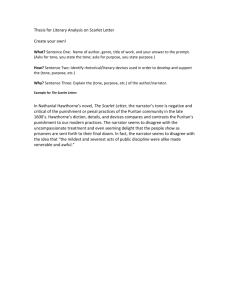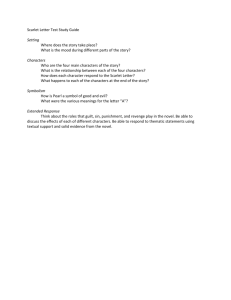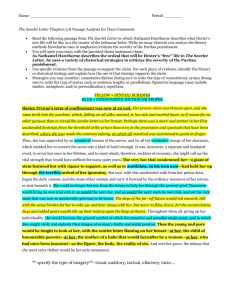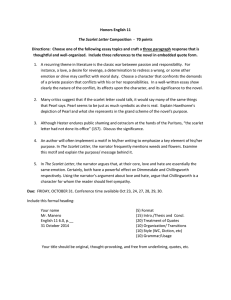Scarlet Letter Lecture 2
advertisement
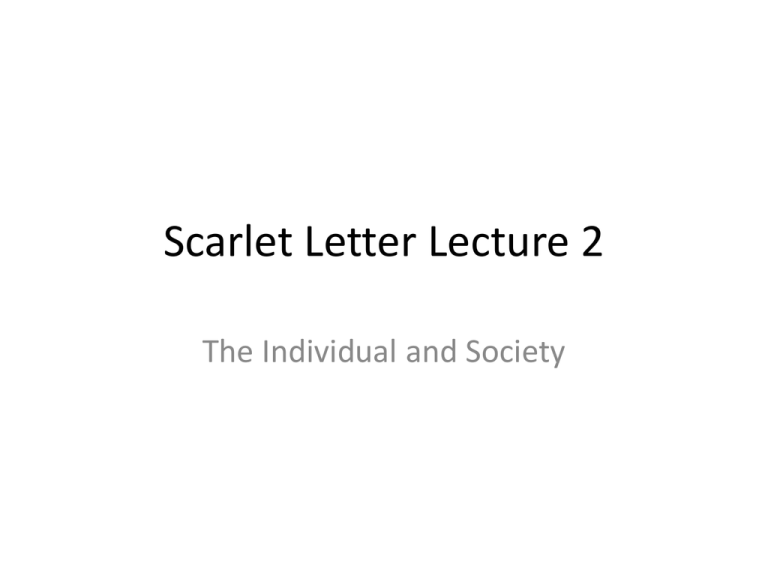
Scarlet Letter Lecture 2 The Individual and Society Lecture Focus • The ‘Custom-House’ prefatory sketch in relation to the actual novel • In what ways does The Custom-House help the reader into the world of The Scarlet Letter? Note title The Scarlet Letter A Romance The Custom-House Introductory To “The Scarlet Letter” • Background about his job as a surveyor in Salem Custom House, and his co-workers; • Background about his Puritan ancestors, and foreshadowing the Puritan theme; • Ideas about writing • Philosophy of Art; and the theme of Art • The concept of a ‘Romance’ • Explains how he ‘discovered’ the manuscript of ‘The Scarlet Letter’; • Narrating voice – Hawthorne; Narrator/author • Writing this lengthy introduction / Induction, has been driven by the ‘autobiographical impulse’ • Connotation: suggestive of irrational motivation; a key word in ‘Scarlet Letter’ • See connections: Implicitly suggests a link between Hester Prynne and the narrator; • Further connotes weaknesses and susceptibilities common to humanity generally • ‘Our impulses are too strong for our judgment sometimes.’ Thomas Hardy’s ‘Tess of the D’Urbervilles’ Bridge / Link • Autobiographical sketch of author in 19th century America • Forms a link / bridge between 19th century (the present of his America) • And the mid-seventeenth century past of New England; And the differences between both time worlds; • Convention of the early 17th century English novel for its authors to represent themselves as editors; • ‘Mankind, says a Chinese manuscript, which my friend M was obliging enough to read and explain…’ from ‘A Dissertation Upon Roast Pig’ by Charles Lamb Two Styles Present (19th century) • Light, genial, humorous, informal; candid, and satirical tone; (relative to the main text) Intended to contrast with • 17th century New England Puritanical Culture • More formal and stern atmosphere and tone Introducing the Puritan Theme Narrator in describing his job as Surveyor • Tells us about his Salemite ancestors; William Hathorne (arrived in New England in 1630) • Was ‘a bitter persecutor of the Quakers, and John Hathorne involved in the notorious Salem witch trials of 1692 • As readers, we become aware of the profound tensions and conflicts in the narrator that inevitably inform the narrative of ‘The Scarlet Letter’ • Such as the tension between Puritan and artist; Hawthorne’s role as Surveyor and Conflicts with Mundane World Narrator/author • Mode of writing: Descriptions of government and fellow employees; • Reflective of how scathingly critical of his fellow workers, notably the Inspector, the patriarch of the Custom-House; • Alludes to his perceived mistreatment as an employee; • Described as “Swept out of office” and replaced by a “worthier successor” Representations of Co-workers Representation of the Inspector p18-20 • Possessed no power of thought, no depth of feeling • A man without morals, intellect, or feeling • Inspector rarely showed regret concerning deaths of his three wives and twenty children, ‘likewise returned to dust’; ‘one brief sigh’ • But notable for his gourmandism; • Obviously very unintellectual company at work • More visceral than cerebral; Ideal Company p26 Tells us Readers who, for him, would make ideal company? • Ralph Waldo Emerson: ‘Self-Reliance’ • David Henry Thoreau: ‘Civil Disobedience’ • Henry Wadsworth Longfellow (Lyric Poet) • Reinforces the extent he sees himself as a man of thought and sensibility • Connections / Link to main text? The Custom-House a Social Microcosm • ‘It contributes greatly towards a man’s moral and intellectual health, to be brought into the habits of companionship with individuals unlike himself, who care little for his pursuits, and whose sphere and abilities he must go out of himself to appreciate.’ p25 • Variety and diversity of humanity; all kinds; • No overarching ideology can accommodate all • Need for Openness and Tolerance • Links / Connections to main text? Philosophy of Narrative Writing Reader / Writer Relationship • Genre of Writing: Autobiographical ‘an autographical impulse’ p7 • Writers should imagine they are speaking to a friend, a person who is “kind and apprehensive, though not the closest friend.” • Personalizing the voice of the writing, yet not revealing one’s innermost self; Must preserve and protect ‘the inmost Me’ p7 • Narrative technique in The Scarlet Letter? From p7 Some authors, indeed... indulge themselves in such confidential depths of revelation as could fittingly be addressed, only and exclusively, to the one heart and mind of perfect sympathy; • Narrator/author stresses the merits of authorial reserve, indirectness, • Keeping the ‘inmost Me of behind its veil’ For example • This is what Hester and Dimmesdale do in preserving their guilty secrets and subversive thoughts from the Puritan community. • Chillingworth’s penetration of Dimmesdale’s self; see Chapter 10 The Leech and His Patient • “I must search this matter to the bottom!” Confessions of an English Opium-Eater by Thomas De Quincey (1821) Nothing, indeed, is more revolting to English feelings than the spectacle of a human being obtruding on our notice his moral ulcers or scars, and tearing away that “decent drapery” which time or indulgence to human frailty may have drawn over them; Narrator’s Voice • Though voice is reserved • Also obtrusive; guiding our reading like a sympathetic friend • Offering explanation, interpretation, commentary to deepen our understanding; • Yet also ambiguously characterized by contradiction and concealment Concept of Romance Perfect place for writing a romance? • A familiar room in the evening, with the moonlight ; moonlight “spiritualizes” the room erasing its physicality and endowing it with “strangeness and remoteness” • In moonlight, the real world and the fairy-tale world meet and interweave with each other; • With moonlight and a dim coal fire, more spiritual imagination is possible The Real and the Fantastic • Story of ‘Scarlet Letter’, also an interweaving / blending of moonlight and a coal fire • A blending / mixing of intellectual ideas and human passions; of the imaginary and fantastic over the probable and the ordinary; • Note: when, where, and how the real world and the fairy-tale world meet each other • Methods of how the real is made to seem fantastic, or the fantastic to appear real; • Noteworthy example: Second scaffold scene Chapter 12: ‘Walking in the shadow of a dream…’ Philosophy of Art / Aesthetics • Foreshadowing theme of Art and Artistry; Art and Sensibility; • The power of Art: enables us to mediate the mental and the emotional sides of our selves; • Our rule-governed, matter-of-fact world, and the imaginary • Codes of discipline and the imagination • Conflict between cold-hearted logic and impassioned • Sense and Sensibility Seeing Connections / links • Hester Prynne’s artistic skills help her to preserve her humanity amidst adversity • And regain her life and re-entry to the community American Culture’s Attitude to Art • A writer of storybooks! What kind of a business in life,— what mode of Glorifying God, or being serviceable to mankind in his day and generation,—may that be? Why the degenerate fellow might as well have been a fiddler. p13 One idle and rainy day p 29 • Fortune; to make a discovery of some little interest • ‘I chanced to lay my hand on a small package, carefully done up in a piece of ancient yellow parchment. This envelope had the air of an official record of some period long past, when clerks engrossed their stiff and formal choreography on more substantial materials than at present.’ • Pretends to have discovered the manuscript in an unused room of the Custom-House; • Presents himself as Editor rather than originator of the story; (again this is pretense) • Effect?
